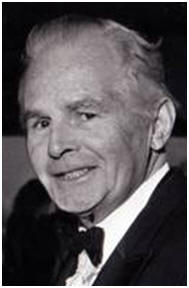 Michael
Lorfing (Class 07-67) sent the article below to advise of the
death of one of our WWII Signal OCS grads. Unfortunately, Jerry
S. Stovers SN did not match the standard 452xxx sequence, and
because he was already a CPT in early 1943, and was never on our
rosters, we didnt know that Jerry had gone through Signal
OCSuntil now. The article reads:
Michael
Lorfing (Class 07-67) sent the article below to advise of the
death of one of our WWII Signal OCS grads. Unfortunately, Jerry
S. Stovers SN did not match the standard 452xxx sequence, and
because he was already a CPT in early 1943, and was never on our
rosters, we didnt know that Jerry had gone through Signal
OCSuntil now. The article reads:
Jerry S. Stover was often ahead of the sound wave as he lived
out his 80-year passion for electronics and wireless
communications.
His adventure started as a 13-year-old amateur radio operator in
1932. During World War II, he helped the Allies develop radar,
working under the cover of a military adviser based at the U.S.
Embassy in London.
He was decorated for establishing the Allied communications base
on Omaha Beach, after the D-Day landing. Later, as a civilian,
he co-founded a company that introduced two-way mobile radio to
police cars, fire trucks and taxicabs in Dallas.
Mr. Stover, 92, died Feb. 7, 2012 of pneumonia at UT
Southwestern University Hospital St. Paul.
Mr. Stover enjoyed the challenges he faced throughout his
career, said his son, Bruce Stover of Dallas.
He always taught me, Whatever you do, do the best you can and
always do a little more, his son said.
Mr. Stover was born in Dallas and moved frequently through his
youth as his father was transferred for his position with Lone
Star Gas Co. He graduated from high school in Rochester, Minn.,
and returned to Dallas to earn a degree in electrical
engineering from Southern Methodist University.
But he volunteered for radar training with the Army Air Forces
in early 1941, when he was an SMU junior.
Mr. Stover received officer training at Fort Monmouth, N.J., and
was commissioned a second lieutenant. He started active duty in
September 1941, clandestinely assigned as a military observer in
London and receiving radar training from the Royal Air Force.
He carried a diplomatic passport and was required to dress as a
civilian when he was not on a British military base, his son
said.
Mr. Stover flew combat missions over the English Channel with
Royal Air Force crews using radar to hunt German submarines that
surfaced to recharge their batteries, said his son Sterling
Stover of Oxfordshire, England.
He was eating dinner in Scotland on Dec. 7, 1941, when he
learned Pearl Harbor had been attacked, bringing America into
the war.
They were the first American military people in Britain, even
though they had already been there for three months, Bruce
Sterling said. The British would come up to them on the street
because we had only been at war for eight hours and say,
Hey, howd you get here so quick?
Mr. Stover was sent to Florida to continue the development work
on radar. He returned to England in January 1944 to help prepare
Operation Overlord, the Allied invasion of Normandy. He was
selected to be signal officer for advance headquarters for the
9th Air Force.
He landed at Omaha Beach on June 8, 1944, two days after D-Day,
and served through five campaigns, including the Battle of the
Bulge.
Mr. Stover received a Bronze Star for establishing a combat
communications post on Omaha Beach.
He also helped liberate a concentration camp north of Munich
late in the war.
There were American troops already there, Bruce Stover said.
He sent his men into the woods to shoot any animals they could
bring in for food.
Mr. Stover was a major at the end of his military duty.
After the war, he completed his education at SMU and formed a
business, Communications Engineering Co., with an SMU classmate,
Tom McMullin.
At first, Mr. Stover worked from his mothers garage in
University Park, installing two-way radios in cars for the FBI
as well as vehicles for fire and police departments.
He dispatched the first taxicab to Union Station in Dallas by
two-way radio, Bruce Stover said.
Early on, Mr. Stover also climbed 300-foot-tall towers in oil
fields across Texas to install antennas for two-way
communications, Bruce Stover said.
The company grew to become Communications Industries Inc., with
subsidiaries that manufactured mobile radio equipment and
provided car telephone service. In 1963 the firm became a
publicly traded company. It was purchased by Pacific Telesis Co.
for $435 million in 1980, Bruce Stover said. The company is now
part of Verizon.
Mr. Stover retired in 1980 but continued to work as a special
assistant to the dean of engineering at SMU and as an industry
consultant.
The Radio Club of America honored Mr. Stover in 1981 with the
Sarnoff Citation for advancement of electronic communication,
and in 2011 with its Armstrong Medal for his contributions to
radio and science.
He was a ham operator for nearly 80
years, most recently with the call letters W5AE.
He acquired an iPhone at the age of 91 and an iPad at 92 on
which he Skyped all over the world, Sterling Stover said. His
love of all things related to wireless communications was as
strong at the end of his life as it was during his childhood
years. While the medium may have changed, his enthusiasm did
not.

